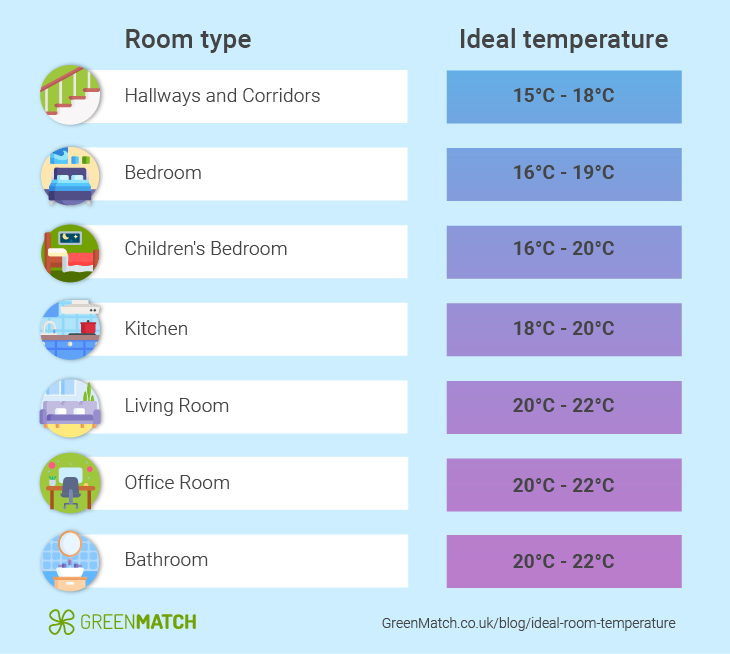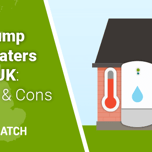- GreenMatch
- Blog
- Ideal Room Temperature
What is the Ideal Room Temperature?


For many of us, finding the ideal room temperature is a challenge. Most of us will feel comfortable in a room between 18 - 22°C. But deciding on where to land the thermostat can cause quite a debate.
Many factors can affect how warm or cold you need a room. Throughout this article, we’ll look at ways you can combat the disagreements while keeping your family safe and keeping an eye on those energy bills.
In this simple guide, we’ll show you how to heat each room in your home to its ideal temperature.
Temperature by Room
Every room in our home has a purpose, and we spend more time in some than others. Rather than heating your entire home to the same temperature, you should consider setting up your radiators to warm each room to fit its purpose.
For example, if you have a baby or small children, you want to ensure their room is healthy to suit their age and the season. According to the NHS, a small baby’s room should be between 16 - 20°C. Remembering this is important, as overheating in small children can lead to devastating outcomes.
Similarly, if you have elderly guests or residents during the colder months, it’s vital to keep their rooms at a consistent temperature of at least 18°C, according to Age UK. This is because the cold puts pressure on the heart, which can increase the risk of a stroke, heart attack and hypothermia.
Our chart below shows the recommended temperature for each room in your home. These are the ideal ranges at which most people will feel comfortable.

As you can see, not every room needs to be at the highest temperature. You could significantly reduce your energy use by lowering the radiator temperatures in places like hallways, storage rooms and corridors. This, in turn, will help to lower your monthly bills and your carbon footprint.
Temperature by Season
Many people also struggle to know what to do with their room temperature during different seasons. The good news is that the ideal temperature should suit most of us all year round. Whether it’s in summer or winter, you should try to keep rooms around 18 - 20°C.
If summer weather means, for example, that ambient temperatures are over 20°C, you may need to take steps to cool down your rooms. This can be achieved by opening windows and doors and ensuring your heating is turned off during the day.
Over the winter months, adjusting your heating to a comfortable temperature between 18 and 20°C should help to keep you warm. However, suppose temperatures outside are in the minus figures. In that case, you should keep your heating on consistently throughout the day to keep your home warm enough for the whole family.
Temperature for Health
We must understand room temperature can hurt our health. Having your home too hot or cold can cause various health problems. This is particularly important if you have small children or live with elderly relatives.
According to the World Health Organisation and the UK Government guidelines, 18°C is the minimum temperature any room should be to ensure good health. This is based on a healthy adult wearing warm clothing and should, therefore, be adapted depending on a person's health and circumstances.
The following table can act as a guide to ensure you avoid any health risks. This shows which temperatures should be avoided and where to safely set your thermostat, depending on who is home.
| Temperature | Guidance |
|---|---|
| 24 - 27°C | Too Hot: Turn down the heat. It could be unsafe for those with heart problems. |
| 18 - 21°C | Comfortable: Ideal temperature for most people. |
| 15 - 16°C | Cool: It may be unsafe for those with respiratory issues—it increases the risk of infection. |
| 9 -12°C | Too Cold: Very unsafe for those with existing health conditions. Increased risk of hypothermia. |

Heating your Home Efficiently
One of the biggest hurdles to families being able to heat their homes properly is the current energy cost. With most homes running multiple energy-consuming appliances (fridges, computers, washing machines, etc.), energy costs mean people are cutting back on the essentials.
Heating a home in the UK accounts for over half the average energy bill. Due to this high cost, homeowners need to look for more efficient ways to heat their homes and save on the energy they use.
Below are some solutions and home improvements you can try to help reduce costs.
-
Ensure your home is well insulated.
Whilst this should include wall and cavity wall insulation, you can also make sure you have double-glazed windows or use draft proofing. Any way you can stop heat escaping from your home is a worthwhile investment. Small, immediate steps can include using thicker curtains and blocking gaps around doors and windows.
-
Use smart heating controls.
Smart controls range from remote smart thermostats and apps to smart radiator valves. These controls vary in price but have different benefits depending on your needs. Full smart controls can allow you to schedule your heating, set individual room temperatures and even control your heating from your phone wherever you are.
Smart radiator valves (known as thermostatic or TRV’s) allow you to set each radiator to a certain temperature. This is a much more bespoke way to heat your home, meaning you can set each area of your home to exactly the temperature you need.
These solutions are a great way to adapt the heating options you already have at home and can potentially save you hundreds of pounds. However, consider an alternative heating system if you want a longer-term solution to cut your bills even more.
Alternative Heating Solutions
One of the best ways to save energy at home is by installing a new, low-carbon heating system, such as a heat pump. These clever solutions use energy found in natural sources, such as air, water or underground, to heat homes.
The benefit of a heat pump is that they are up to 300% efficient. This means that each unit of energy you use to run it can provide up to 3x as much heating output. This is a huge difference from the average gas boiler, which can still only provide around 92% even at modern A-rated levels.
Heat pumps also produce minimal carbon emissions, meaning you can greatly reduce your carbon footprint by replacing your gas boiler. Currently, 19% of the UK’s carbon emissions come from how we heat our homes and buildings. By switching to a low-carbon system, you can save on your energy bills and greatly reduce the negative impact on our environment.
If your home had a heat pump, you could see savings of around £3,000 per year, depending on what kind of heating system you replace. Further savings can be made if you pair a heat pump with a renewable energy source, such as solar panels.
Summary
The ideal room temperature may differ slightly for everyone, but choosing between 18 - 20°C should keep your home healthy and comfortable. Everyone responds differently depending on age, health and seasonal changes, but everyone should be happy as long as you keep each room at the right level to suit its purpose.

Becky is an experienced SEO content writer specialising in sustainability and renewable trends. Her background in broadcast journalism inspires reliable content to help readers live more sustainably every day.
We strive to connect our customers with the right product and supplier. Would you like to be part of GreenMatch?





